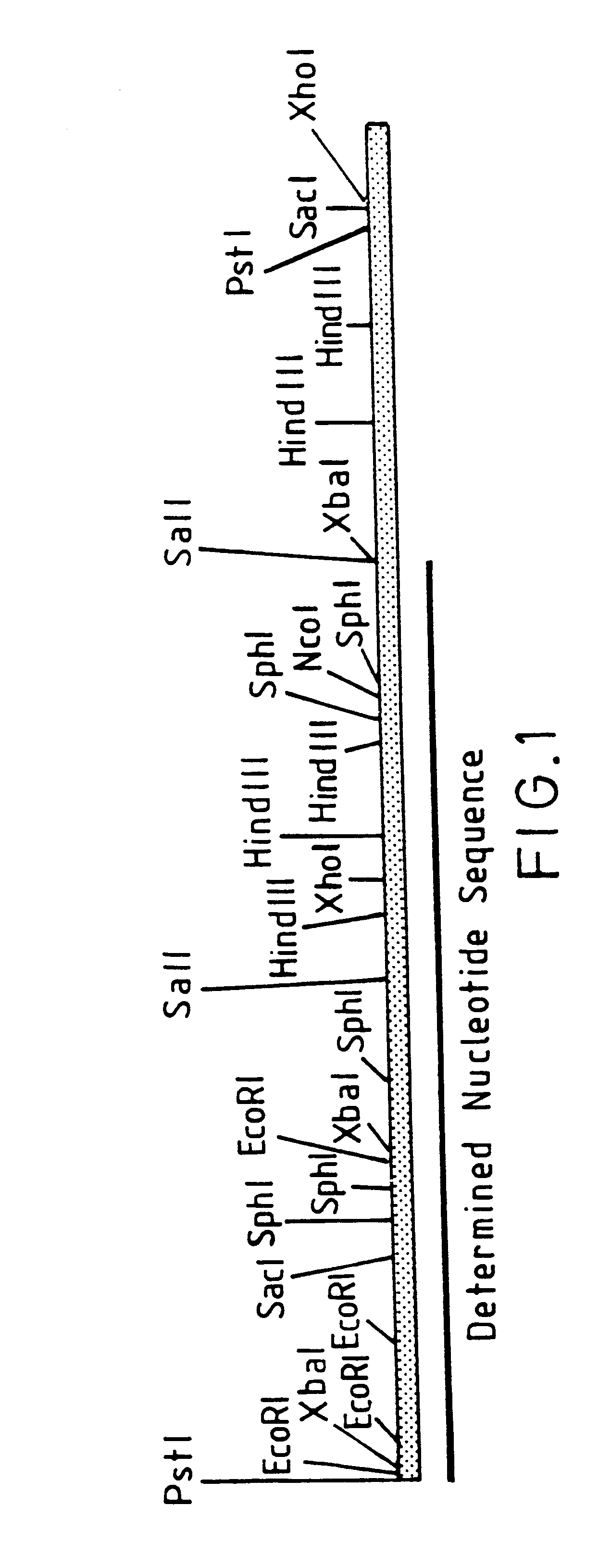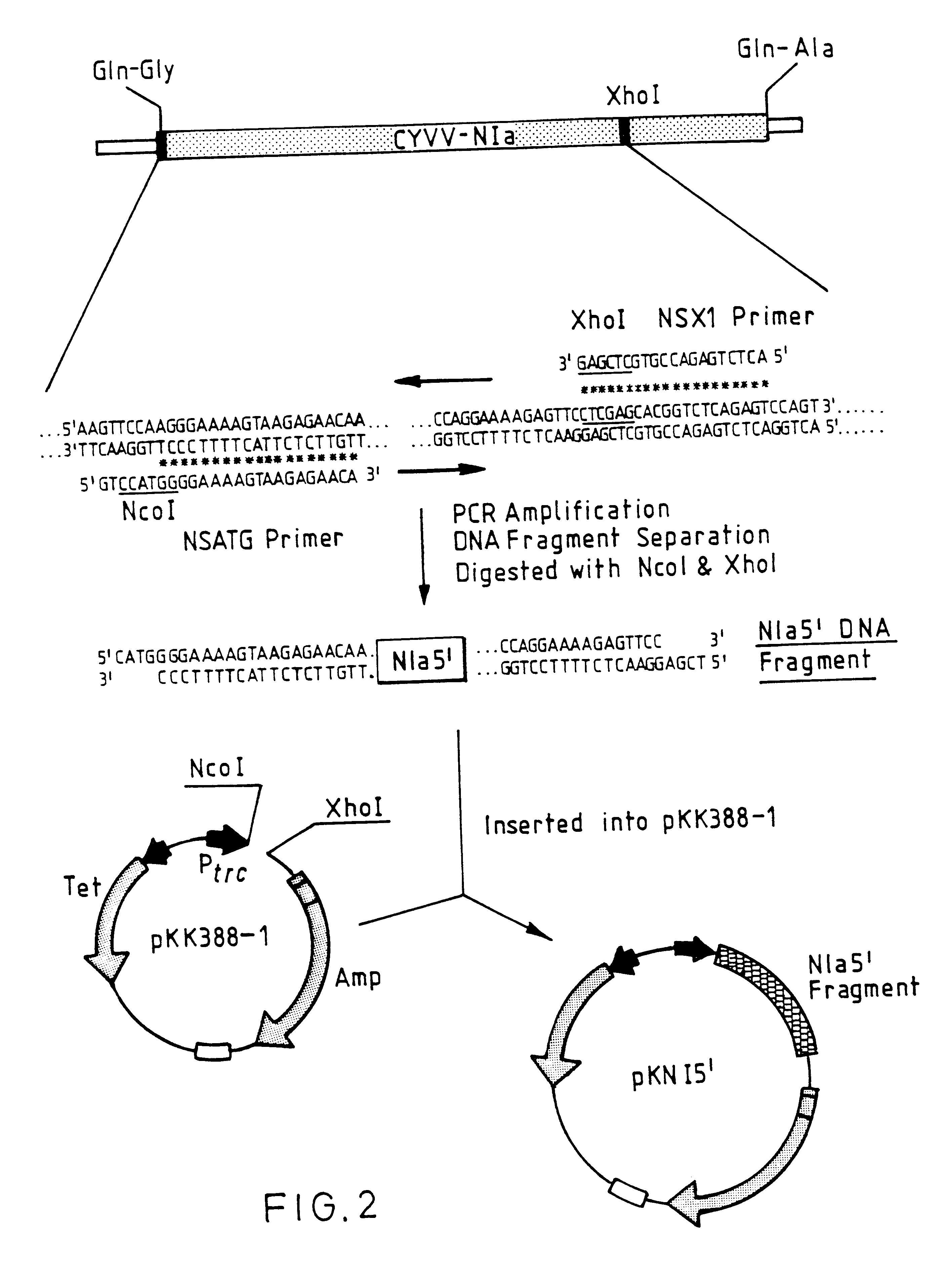Expression systems utilizing autolyzing fusion proteins and a novel reducing polypeptide
a technology of fusion proteins and reducing polypeptides, which is applied in the direction of fusion polypeptides, peptide/protein ingredients, dna/rna fragmentation, etc., can solve the problems of large loss of end product, polypeptides which cannot be easily expressed in exogenous systems, and polypeptides which cannot be expressed in large amounts
- Summary
- Abstract
- Description
- Claims
- Application Information
AI Technical Summary
Problems solved by technology
Method used
Image
Examples
example 2
Preparation of a cDNA Library
A cDNA library was prepared by the Okayama-Berg method.
5 .mu.g of poly(A).sup.+ RNA and 24 units of reverse transcriptase (Seikagaku Corp.) were allowed to react at 42.degree. C. for 1 hour in 20 .mu.l of reverse transcriptase reaction solution.
The reaction was stopped by the addition of 2 .mu.l of 0.25 M EDTA and 1 .mu.l of 10% SDS, and the solution was then deproteinized with 20 .mu.l of a phenol / chloroform mixture (1:1 v / v). Following centrifugation to remove the proteinaceous fraction, 20 .mu.l of 4 M ammonium acetate and 80 .mu.l of ethanol were added to the supernatant which was then cooled at -70.degree. C. for 15 minutes. After this time, the precipitate was collected by centrifugal separation, washed with 75% ethanol and then dried under reduced pressure.
The dried precipitate was dissolved in 15 .mu.l of terminal transferase reaction solution and warmed at 37.degree. C. for 3 minutes. At the end of this time, .18 units of terminal deoxynucleotid...
example 3
Preparation of an Oligonucleotide Probe
Based on the AUUUA sequence in the 3' non-translated region of the mRNA of cytokines, the 15-base oligonuclectide 5'-TAAATAAATAAATAA-3' (sequence ID number 13), designated ATT-3, was chemically synthesized. Synthesis was performed using the 380B automatic DNA synthesizer (Perkin-Elmer Japan Applied Biosystems) following the directions supplied in the accompanying manual. The method employed was the phosphoamidite method described by Caruthers et al. [Matteucci, M. D. and Caruthers, M. H. (1981) J. Am. Chem. Soc. 103, 3185-3191]. After synthesis of the 15-mer, the resulting oligonuculeotide was severed from the support and the protecting groups were removed. The resulting oligonucleotide solution was lyophilized to form a powder which was then dissolved in distilled water and stored frozen at -20.degree. C. until the time of use.
example 4
Screening the cDNA Library
6,500 colonies generated from the cDNA library prepared in Example 2 above were fixed on a nitrocellulose filter in accordance with the method described by Grunstein and Hogness [Grunstein, M. and Hogness, D. S. (1975) Proc. Natl. Acad. Sci. USA 72, 3961-3965]. The ATT-3 probe prepared in Example 3 was 5'-labelled with .sup.32 P following standard procedures (see "Molecular Cloning--A Laboratory Manual"), and the labelled probe was used for colony hybridization.
Pre-hybridization was performed at 37.degree. C. for 3 hours in the following: 6.times.SSC, 1.times.Denhardt solution, 0.25% SDS, 0.05% sodium pyrophosphate and 100 .mu.g / ml of denatured salmon sperm DNA. Hybridization was then performed overnight at 31.degree. C. in the following: 6.times.SSC, 1.times.Denhardt solution, 17 .mu.g / ml of yeast tRNA and 0.05% sodium pyrophosphate containing the .sup.32 P-labeled probe ATTT-3.
On the following day, the nitrocellulose filter was washed at room temperature ...
PUM
| Property | Measurement | Unit |
|---|---|---|
| Angle | aaaaa | aaaaa |
Abstract
Description
Claims
Application Information
 Login to View More
Login to View More - R&D
- Intellectual Property
- Life Sciences
- Materials
- Tech Scout
- Unparalleled Data Quality
- Higher Quality Content
- 60% Fewer Hallucinations
Browse by: Latest US Patents, China's latest patents, Technical Efficacy Thesaurus, Application Domain, Technology Topic, Popular Technical Reports.
© 2025 PatSnap. All rights reserved.Legal|Privacy policy|Modern Slavery Act Transparency Statement|Sitemap|About US| Contact US: help@patsnap.com



